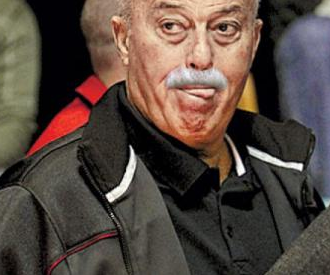Copyright law is frequently misused as a tool to censor unwanted online criticism. And often, this misuse does not make it into court. But one such case has recently made its way up to the Eleventh Circuit Court of Appeals. And yesterday, EFF filed a “friend of the court” brief, urging the court to consider the First Amendment interests at play when copyright is used to silence public criticism.

The "unflattering" Raanan Katz photo
The case, Katz v. Chevaldina, involves a blogger’s use of a photograph of Raanan Katz—the owner of a number of shopping centers throughout Florida and a minority owner of the Miami Heat—in blog posts critical of Katz’s business practices. The photo was originally taken by a photographer in Israel, who took the photo for use in a newspaper article about how Katz might be purchasing an interest in an Israeli basketball team. Katz views the photograph, included here, as “unflattering,” and wants it taken off the web. In an effort to get the photo offline, he managed to get an assignment of copyright from the photographer. Days after that assignment—and before even registering his newly acquired copyright with the U.S. Copyright Office—Katz sued the blogger for copyright infringement in federal court. Katz also sued Google after Google refused to comply with a takedown notice Katz had sent the search engine giant pursuant to the Digital Millennium Copyright Act (DMCA). (Google was later dropped from the case.) Unsurprisingly, the case has only brought more attention to the photograph—a classic example of the Streisand effect.
The blogger moved for summary judgment on the ground that her use of the photograph for the purpose of criticizing Katz was fair use and protected under federal copyright law. The district court agreed. Katz has appealed the district court’s decision, arguing that the blogger’s use of the photo was not a protected fair use.
In our brief, we ask the Eleventh Circuit to affirm the lower court’s fair use holding. The fair use doctrine ensures that the public can use copyrighted works for a variety of purposes, including criticism in a blog post. We urged the court to carefully consider the fact that Katz is using copyright as a tool for censorship.
Unfortunately, using copyright to censor not a new or uncommon phenomenon. Abuse of copyright can affect not only an individual speaker’s right to speak, but also the public’s right to receive information. This impact on free speech should inform courts’ fair use analysis. And a correct ruling in favor of fair use here should help deter misuse of copyright law in the future.
We also responded to a few of the more “creative” arguments Katz made in his brief to the Court of Appeals. Of particular note, he argued that for a secondary use of a copyrighted photograph to be transformative—one of the four fair use factors—an inherently positive photograph must be used for negative commentary (or, presumably, vice versa). According to Katz, because the photograph at issue was unflattering, and thus negative, the blogger’s use of the photograph in negative blog posts was not transformative. As we told the Court of Appeals, this is simply not the law.
We hope the Court of Appeals will reach the right result and find fair use here. We expect to have a decision later this year.


